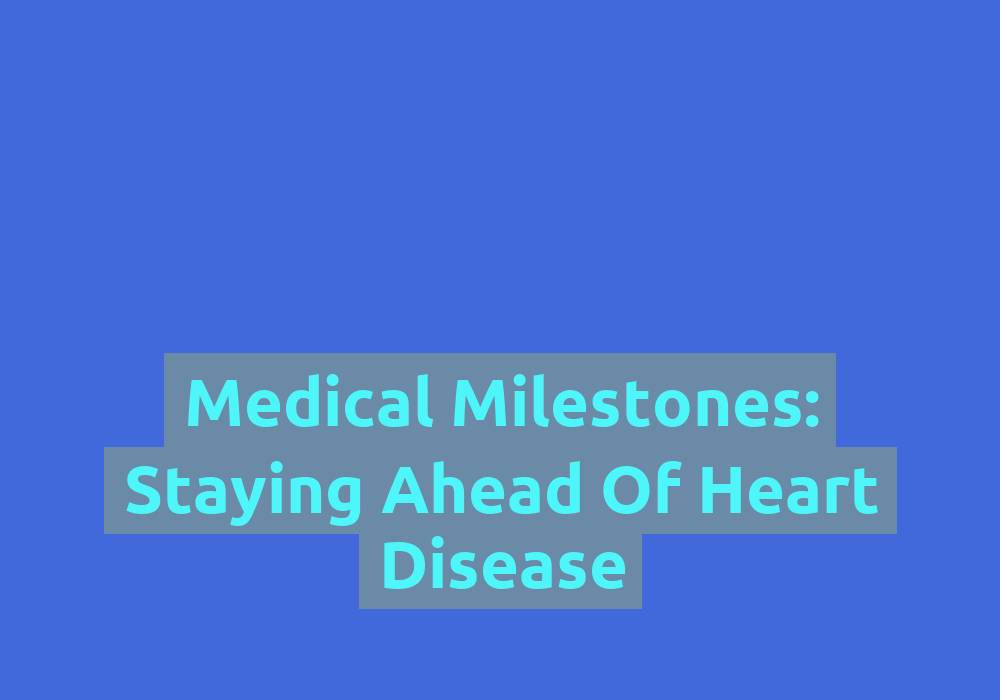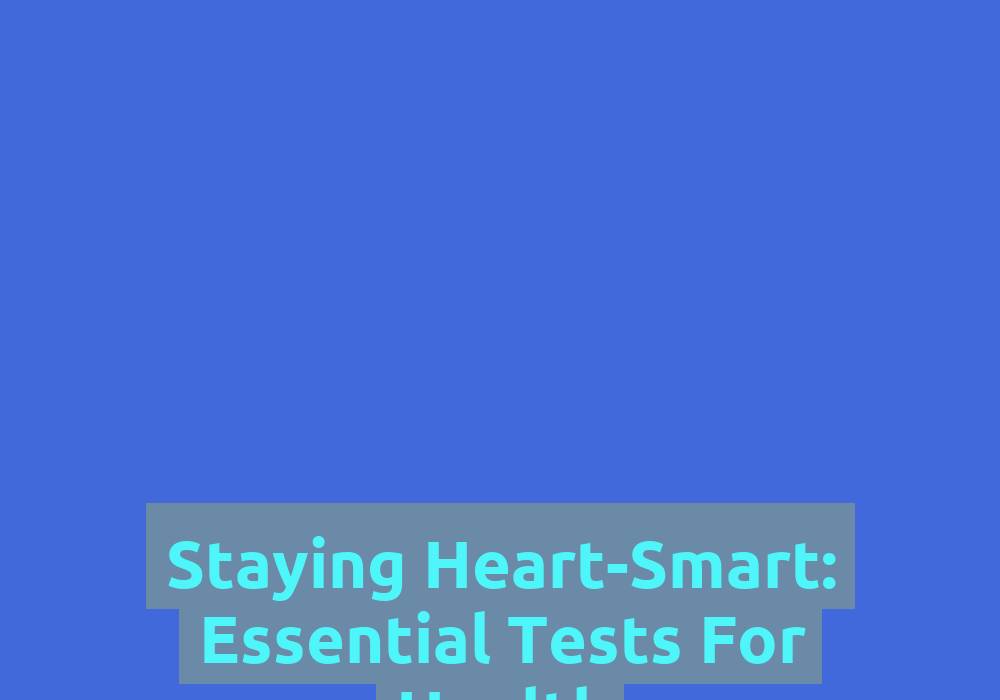Medical Milestones: Staying Ahead of Heart Disease

Heart disease continues to be a leading cause of death worldwide. However, with advancements in medical research and technology, there have been significant milestones achieved in the prevention, diagnosis, and treatment of this prevalent condition. In this article, we will explore some of these medical milestones and delve into strategies individuals can adopt to stay ahead of heart disease.
Understanding Heart Disease
Before we delve into the medical milestones, it is essential to have a clear understanding of heart disease. Heart disease refers to a range of conditions that affect the heart’s structure and function. These conditions can include coronary artery disease, heart rhythm problems, heart failure, and congenital heart defects, among others.
Heart disease is a complex condition that can have various causes and risk factors. Understanding these factors is crucial in developing effective preventive measures and treatment strategies. Some of the common risk factors for heart disease include:
- High blood pressure: Elevated blood pressure puts strain on the heart and increases the risk of heart disease.
- High cholesterol: High levels of cholesterol in the blood can lead to the formation of plaque in the arteries, restricting blood flow to the heart.
- Smoking: Smoking damages the blood vessels and contributes to the development of atherosclerosis, a condition characterized by the buildup of plaque in the arteries.
- Obesity: Excess weight puts additional stress on the heart and increases the likelihood of developing heart disease.
- Diabetes: Individuals with diabetes are at a higher risk of developing heart disease due to elevated blood sugar levels.
- Family history: A family history of heart disease can increase an individual’s risk of developing the condition.
Medical Milestones in Preventing Heart Disease
- Advancements in Cardiac Imaging Techniques: Over the years, medical professionals have made significant strides in cardiac imaging techniques, allowing for improved diagnosis and prevention of heart disease. Modern imaging techniques such as computed tomography (CT) scans, magnetic resonance imaging (MRI), and echocardiography provide detailed visualization of the heart’s structure and function, aiding in early detection of potential issues.
Cardiac imaging plays a crucial role in identifying early signs of heart disease and assessing the overall health of the heart. These advanced imaging techniques allow healthcare providers to:
- Identify blockages or narrowings in the coronary arteries, which can help in the early detection of coronary artery disease.
- Evaluate the size and function of the heart chambers, enabling the detection of potential heart failure or structural abnormalities.
- Assess the presence of blood clots or abnormalities in the heart valves, providing valuable information for appropriate treatment planning.
- Lifestyle Modifications: One of the most significant milestones in preventing heart disease is the recognition of the importance of lifestyle modifications. Adopting a healthy lifestyle can significantly reduce the risk of heart disease. This includes engaging in regular physical activity, maintaining a balanced diet rich in fruits, vegetables, whole grains, and lean proteins, avoiding tobacco products, limiting alcohol consumption, and managing stress.
Leading a heart-healthy lifestyle plays a crucial role in preventing the onset and progression of heart disease. Here are some key lifestyle modifications individuals can adopt:
- Regular exercise: Engaging in moderate-intensity aerobic activities, such as brisk walking, jogging, or cycling, for at least 150 minutes per week can help improve cardiovascular health.
- Healthy diet: Consuming a diet rich in fruits, vegetables, whole grains, lean proteins, and healthy fats can help maintain optimal heart health. Limiting the intake of processed foods, saturated fats, and added sugars is also important.
- Tobacco cessation: Quitting smoking and avoiding exposure to secondhand smoke is essential in reducing the risk of heart disease. Support programs, nicotine replacement therapies, and counseling services can aid in smoking cessation.
- Moderate alcohol consumption: While moderate alcohol consumption may have some cardiovascular benefits, excessive drinking can increase the risk of heart disease. It is important to limit alcohol intake to moderate levels, which means up to one drink per day for women and up to two drinks per day for men.
- Stress management: Chronic stress can contribute to the development of heart disease. Adopting stress-management techniques such as meditation, deep breathing exercises, and engaging in hobbies can help reduce stress levels and promote heart health.
- Cholesterol Management: Another crucial milestone in preventing heart disease is the development of effective cholesterol-lowering medications, such as statins. These medications help to reduce the levels of harmful cholesterol in the blood, thereby lowering the risk of developing heart disease. Additionally, regular monitoring of cholesterol levels and making dietary changes can further contribute to maintaining healthy cholesterol levels.
Maintaining healthy cholesterol levels is essential for heart health. Here are some strategies to manage cholesterol effectively:
- Dietary modifications: Consuming a diet low in saturated fats, trans fats, and cholesterol can help reduce harmful LDL cholesterol levels. Including heart-healthy fats, such as those found in olive oil, avocados, and nuts, can be beneficial. Adding soluble fiber to the diet, found in fruits, vegetables, and whole grains, can also help lower cholesterol levels.
- Regular exercise: Engaging in physical activity regularly can help raise HDL cholesterol (the “good” cholesterol) levels and lower LDL cholesterol. Aim for at least 30 minutes of moderate-intensity aerobic exercise most days of the week.
- Medication: If lifestyle modifications are not sufficient to lower cholesterol levels, healthcare providers may prescribe cholesterol-lowering medications, such as statins. These medications work by inhibiting the production of cholesterol in the liver and promoting the removal of LDL cholesterol from the bloodstream.
- Blood Pressure Control: High blood pressure is a significant risk factor for heart disease. Medical advancements have led to the development of various antihypertensive medications, allowing individuals to effectively manage their blood pressure levels. Regular blood pressure monitoring, adherence to prescribed medications, and lifestyle modifications play a vital role in controlling blood pressure and preventing heart disease.
Controlling blood pressure is crucial in reducing the risk of heart disease. Here are some strategies to manage blood pressure effectively:
- Healthy diet: Following the Dietary Approaches to Stop Hypertension (DASH) diet, which emphasizes fruits, vegetables, whole grains, lean proteins, and low-fat dairy products, can help lower blood pressure.
- Reducing sodium intake: Limiting sodium consumption to less than 2,300 milligrams per day (or even lower for certain individuals, such as those with high blood pressure) can help control blood pressure.
- Regular physical activity: Engaging in regular aerobic exercise, such as brisk walking, swimming, or cycling, for at least 150 minutes per week can help lower blood pressure.
- Stress management: Chronic stress can contribute to elevated blood pressure. Adopting stress-reducing techniques, such as deep breathing exercises, mindfulness meditation, and engaging in hobbies, can help manage stress levels.
- Smoking Cessation: The recognition of the detrimental effects of smoking on cardiovascular health has led to various programs aimed at smoking cessation. Smoking cessation support systems, nicotine replacement therapies, and counseling services have significantly contributed to reducing the number of individuals who smoke, consequently lowering the incidence of heart disease.
Quitting smoking is one of the most important steps individuals can take to protect their heart health. Here are some strategies to quit smoking:
- Seek professional help: Consult healthcare providers who can provide guidance and support in quitting smoking. They can prescribe medications or recommend nicotine replacement therapies to help manage nicotine withdrawal symptoms.
- Join support programs: Participating in smoking cessation support programs, such as group therapy or counseling, can provide individuals with the necessary tools and encouragement to quit smoking.
- Identify triggers: Recognize situations or activities that trigger the urge to smoke and develop strategies to cope with them. This may involve finding alternative activities or distractions to replace smoking.
- Build a support network: Surrounding oneself with supportive friends and family members who encourage the quit-smoking journey can significantly increase the chances of success.
Medical Milestones in Diagnosing Heart Disease
- Electrocardiogram (ECG): The introduction of the electrocardiogram has been a significant milestone in diagnosing heart disease. An ECG measures the electrical activity of the heart, providing valuable information about its rhythm, rate, and any abnormalities. This non-invasive and relatively simple test aids in the diagnosis of various heart conditions.
An electrocardiogram (ECG) is a painless and quick test that helps diagnose various heart conditions. It involves attaching electrodes to the skin to detect and record the electrical signals produced by the heart. Some common uses of ECG include:
- Diagnosing arrhythmias: An ECG can detect irregular heart rhythms, such as atrial fibrillation, ventricular tachycardia, or bradycardia, which may indicate underlying heart disease.
- Assessing heart damage: A heart attack can cause damage to the heart muscle. An ECG can help identify changes in the electrical patterns of the heart, indicating areas of damage.
- Evaluating heart enlargement: An enlarged heart, which can be a sign of various heart conditions, can be detected through changes in the ECG readings.
- Monitoring treatment: ECGs are often used to monitor the effectiveness of certain medications or interventions in managing heart conditions.
- Cardiac Biomarkers: Medical advancements have led to the identification of specific biomarkers that can indicate the presence of heart disease. Biomarkers such as troponin, B-type natriuretic peptide (BNP), and C-reactive protein (CRP) help in diagnosing conditions such as heart attacks, heart failure, and inflammation within the cardiovascular system. These biomarkers, when combined with other diagnostic tools, enhance the accuracy of diagnosing heart disease.
Cardiac biomarkers are substances released into the bloodstream in response to heart damage or stress. They can help in the diagnosis and prognosis of various heart conditions. Here are some commonly used cardiac biomarkers:
- Troponin: Troponin is a highly sensitive and specific biomarker used to diagnose heart attacks. Elevated levels of troponin in the blood indicate damage to the heart muscle.
- B-type natriuretic peptide (BNP): BNP is released by the heart in response to increased pressure or fluid overload. Elevated BNP levels can indicate heart failure.
- C-reactive protein (CRP): CRP is an inflammatory biomarker that can help identify inflammation within the cardiovascular system. Elevated CRP levels may indicate an increased risk of heart disease.
- Coronary Angiography: Coronary angiography is a procedure that allows for the visualization of the heart’s blood vessels. This diagnostic tool involves injecting a contrast dye into the arteries and taking X-ray images. By identifying any blockages or narrowings in the coronary arteries, physicians can determine the presence of coronary artery disease, enabling timely intervention and treatment.
Coronary angiography plays a crucial role in diagnosing coronary artery disease (CAD) and determining the extent and severity of blockages in the heart’s blood vessels. Here’s how the procedure is performed:
- Catheter insertion: A thin, flexible tube (catheter) is inserted into a blood vessel, usually in the groin or arm, and threaded to the coronary arteries.
- Contrast dye injection: Contrast dye is injected through the catheter, which helps visualize the coronary arteries on X-ray images.
- X-ray imaging: X-ray images are taken as the contrast dye flows through the coronary arteries, highlighting any areas of blockages or narrowings.
- Assessment and treatment planning: Based on the results of the coronary angiography, healthcare providers can determine the need for further interventions, such as angioplasty, stenting, or bypass surgery.
Medical Milestones in Treating Heart Disease
- Coronary Angioplasty and Stenting: Coronary angioplasty is a minimally invasive procedure used to open blocked or narrowed coronary arteries. During this procedure, a thin tube with a balloon at the tip is inserted into the affected artery. The balloon is then inflated, pushing the plaque against the artery walls and restoring blood flow. In some cases, a stent (a small mesh tube) is placed in the artery to keep it open and prevent re-narrowing.
Coronary angioplasty and stenting are commonly performed interventions to restore blood flow to the heart. Here’s an overview of the procedure:
- Catheter insertion: A catheter with a deflated balloon is inserted into a blood vessel, usually in the groin or arm, and guided to the blocked coronary artery.
- Balloon inflation: The balloon is inflated at the site of the blockage, compressing the plaque against the artery walls and widening the artery.
- Stent placement: In some cases, a stent is inserted and expanded within the artery to provide structural support and maintain the artery’s patency.
- Restoring blood flow: After the plaque is compressed and the artery is widened or supported by a stent, blood flow is restored, relieving symptoms and reducing the risk of a heart attack.
- Bypass Surgery: Coronary artery bypass grafting (CABG) is a surgical procedure used to treat severe coronary artery disease. It involves taking a healthy blood vessel, often from the leg or chest, and grafting it onto the blocked coronary artery. This bypasses the blocked
Q: What is heart disease?
A: Heart disease refers to a range of conditions that affect the heart’s structure and function, including coronary artery disease, heart rhythm problems, heart failure, and congenital heart defects.
Q: What are the common risk factors for heart disease?
A: Common risk factors for heart disease include high blood pressure, high cholesterol, smoking, obesity, diabetes, and a family history of heart disease.
Q: How can I prevent heart disease?
A: To prevent heart disease, you can adopt a healthy lifestyle by engaging in regular exercise, maintaining a balanced diet, avoiding tobacco products, limiting alcohol consumption, managing stress, and getting regular check-ups.
Q: What are some medical milestones in treating heart disease?
A: Some medical milestones in treating heart disease include advancements in cardiac imaging techniques, lifestyle modifications, cholesterol management, blood pressure control, smoking cessation, electrocardiogram (ECG), cardiac biomarkers, coronary angiography, coronary angioplasty and stenting, and bypass surgery.

